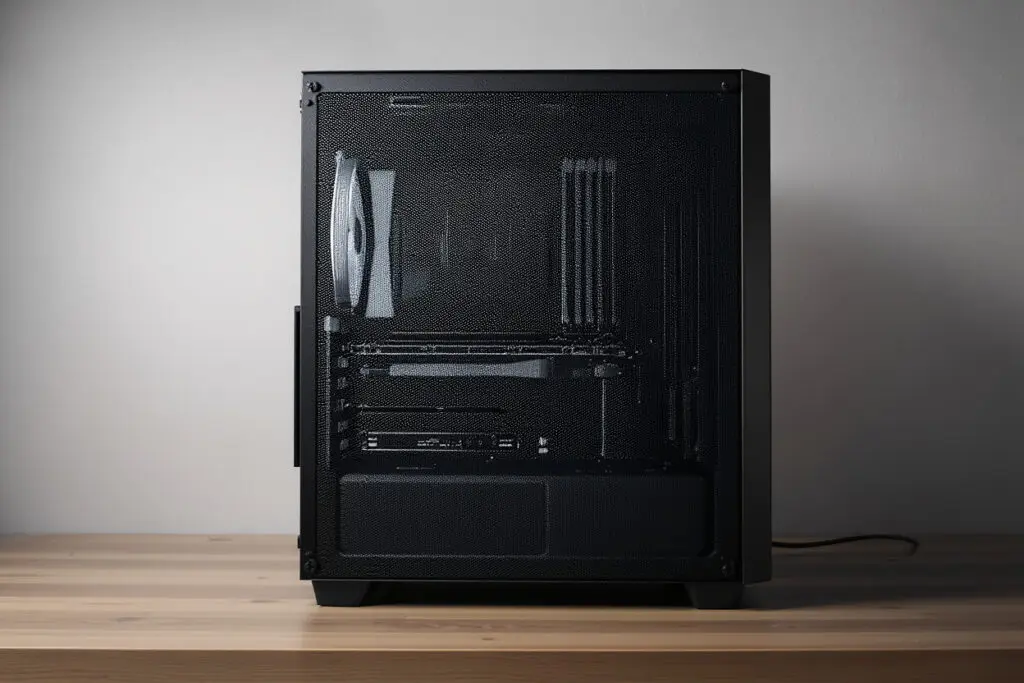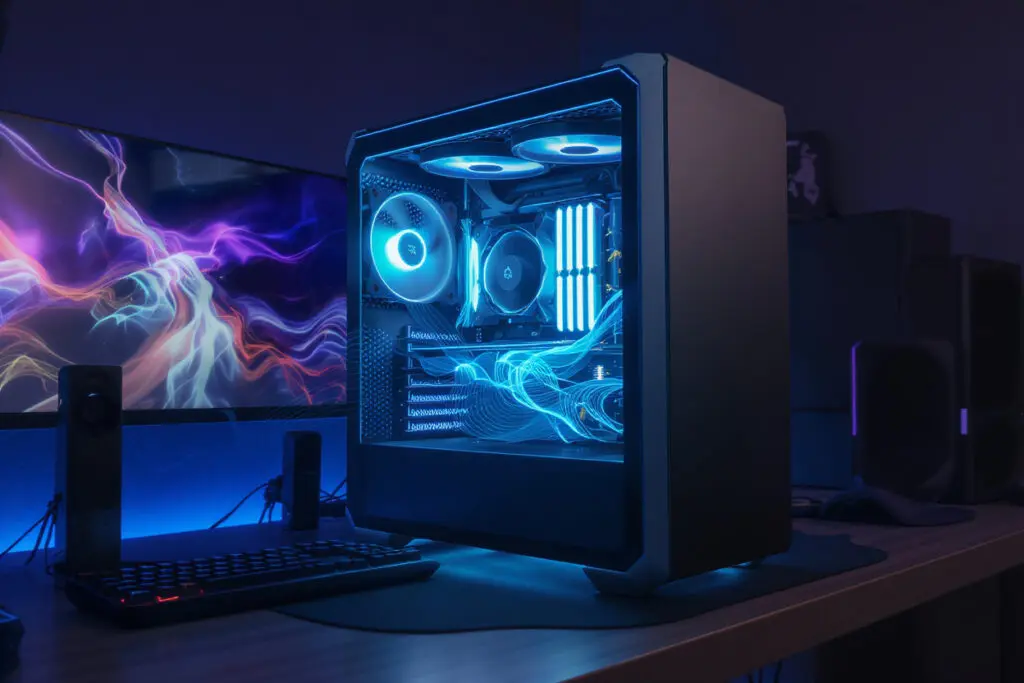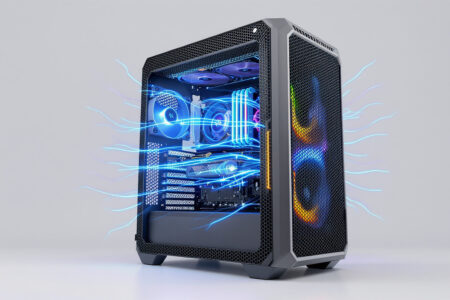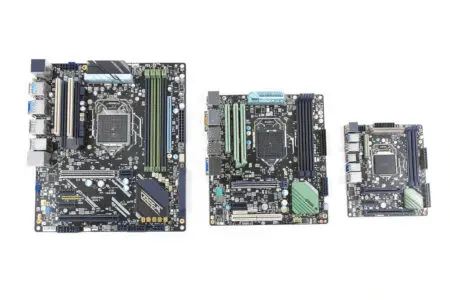You know the sound. That high-pitched whine that cuts through everything. You’re trying to sneak up on an enemy, listening for the faintest footstep, but all you can hear is your own PC screaming like a tiny jet engine. It completely shatters the immersion. I’ve been there. My very first build was a monster, a powerhouse of parts I was incredibly proud of.
But it was loud. Obnoxiously loud. That’s when I learned a tough lesson: all the graphical horsepower in the world doesn’t mean a thing if your gaming rig sounds like a leaf blower. That frustration started me on a mission to find the answer to a question every serious gamer eventually asks: what are the quietest PC cases for gaming?
This is more than just stuffing foam into a steel box. Building a truly silent PC is an art form, a balancing act of airflow, acoustics, and smart choices. I’ve spent years building PCs, from flashy, loud RGB monsters to rigs so silent I’d literally put my hand on the exhaust just to feel if the fan was spinning. This guide is everything I’ve learned along the way. We’re going to break down what actually makes a case quiet, where you can’t cut corners, and which cases will finally let you hear your game instead of your computer.
More in Hardware Category
The Best PC Case Fan Setup for Airflow
How Many Case Fans Do I Need For a Gaming PC
Key Takeaways
- It’s Not Just Foam: The best quiet cases are engineered systems, using a smart mix of sound-dampening materials, solid construction, and clever airflow designs to kill noise.
- Airflow Is Everything: People worry that silent cases will cook their parts. Not true. The top designs cool brilliantly using indirect airflow and big, slow fans that are incredibly quiet.
- A Quiet Case Isn’t a Magic Bullet: Your case can only do so much. If you put a screeching, low-quality graphics card cooler inside, you’re still going to hear it. A quiet build needs quiet parts.
- There’s a Silent Case for You: No matter your goal—total silence, quiet performance, or a compact build—there’s a case out there built for it.
- You Can Quiet Your Current Rig: Don’t want to buy a new case? You can still make a huge difference. Swapping out fans and tweaking settings in your BIOS are easy, effective ways to lower the noise.
So, Why Does Your Gaming PC Sound Like It’s About to Take Off?
To fix the noise, you first have to know where it’s coming from. Your PC isn’t just one sound; it’s a whole symphony of buzzing and whirring. The main offenders, of course, are the fans. You’ve got one on your CPU cooler, a few on your graphics card, one in the power supply, and a handful moving air through the case. Every single fan is a potential noise problem.
The sound they make isn’t just about raw speed. It’s about the bearings they use, the shape of their blades, everything. Cheap fans, the kind that get tossed into budget cases, use simple bearings that produce a distinct, irritating drone.
My first build is a perfect example. It was a collection of parts I’d managed to scrape together. The case itself was made of thin, cheap metal that seemed to amplify every vibration. The included fans were junk. The second I launched a game, they’d spin up to full blast, and the noise was just awful. Not a powerful roar, but a high, grating whine. It was the sound of cutting corners. On top of that, you can get high-frequency coil whine from your GPU or the classic clicking from an old-school mechanical hard drive. A good quiet case is designed to fight all of it.
Can a PC Case Really Make That Much of a Difference?
One hundred percent, yes. It’s easy to think of a case as just a container, but its design is fundamental to how loud your finished PC will be. A flimsy, poorly made case vibrates and acts like an echo chamber. A purpose-built quiet case, however, is designed from the very beginning to absorb and contain sound.
It’s a completely different mindset.
How Do Quiet Cases Actually Work Their Magic?
These cases aren’t just standard designs with some padding thrown in. They attack noise from multiple angles. The most visible feature is sound-dampening material. We’re not talking about packing peanuts; this is high-density foam or heavy, mass-loaded vinyl, materials specifically chosen to absorb vibrations. It’s applied to the inside of the case panels, trapping fan noise before it ever reaches your ears.
Solid panels are another huge part of the formula. Your typical gaming case is covered in mesh for airflow, but that also lets sound escape freely. Silent cases use solid front and top panels as a physical barrier. To keep things from overheating, they use smartly designed side vents. This creates an indirect path for air, which lets air in but forces sound waves to bounce around and die out, effectively muffling the fans behind the panel.
Isn’t Blocking Airflow a Terrible Idea for a Gaming PC?
This is the big question, the one everyone rightfully asks. High-end gaming parts produce a ton of heat, and suffocating them is the last thing you want to do. The designers of the best quiet cases are way ahead of us. They haven’t killed the airflow; they’ve just made it more intelligent.
It’s like the difference between opening a window to let in a breeze versus using a central air conditioner. One is brute force; the other is controlled. A top-tier silent case creates a specific, directed path for the air. Cool air is pulled in through the side vents, flows directly over your hot components like the CPU and GPU, and is then immediately pushed out by an exhaust fan. It’s clean and efficient.
On top of that, these cases often use larger 140mm fans instead of the standard 120mm. A bigger fan moves the same volume of air as a smaller one while spinning much slower. Slower spins mean way less noise. It’s not about starving your components; it’s about being smarter with how you cool them.
What Should I Look For When Shopping for a Silent Case?
Once you start shopping, you’ll see the word “silent” everywhere. But not all quiet cases are built the same. If you know the specific features that matter, you can spot the real deal from the imposters. You have to look past the marketing and at the actual engineering.
Are All Those Sound-Dampening Panels Really the Same?
Definitely not. The quality of the dampening material makes a massive difference. Top-shelf cases from brands like Fractal Design and be quiet! use thick, industrial-grade foam that absorbs a wide range of sound frequencies. It handles everything from the low hum of a fan motor to the high-pitched whine of a GPU.
Cheaper cases often use a thin, flimsy foam that might take the edge off the highest frequencies but lets all the annoying, droning sounds pass right through. Some of the best cases even use multiple layers, combining foam with a heavy material like a bitumen sheet to tackle both airborne sound and vibrations traveling through the metal itself. Always check reviews to see how the dampening actually performs in the real world.
Does the Case’s Size and Layout Matter for Noise?
It plays a huge part. A roomy mid-tower case is almost always going to be quieter than a tiny, cramped build. The reason is simple: more space means more air, and more air means your fans can spin slower to get the job done. And slow fans are quiet fans.
Modern layouts are also designed with silence in mind. Look for cases that have a power supply shroud—that metal basement at the bottom. It hides the PSU and its fan, separating its heat and noise from the rest of your components. This makes cooling more efficient and contains a major noise source. Another great feature is isolated hard drive cages with rubber grommets, which stop the vibrations from a mechanical drive from turning your whole case into a speaker.
What About the Fans Included with the Case?
Don’t overlook the stock fans. They’re a massive part of the equation. A truly great silent case will come with fans designed for quiet operation right out of the box. For example, be quiet! bundles their excellent Pure Wings or Silent Wings fans with their cases. Fractal Design includes their high-quality Dynamic fans. These aren’t cheap afterthoughts; they are premium, quiet-focused fans.
I was trying to quiet down an older PC, and the case itself was decent, but the fans were loud and buzzy. I bought a pack of premium Noctua fans and swapped them out. It took maybe half an hour. The difference was staggering. The annoying hum was just gone, replaced by a soft whisper of moving air. It was a revelation. When you’re comparing cases, factor in the quality of the included fans. It could save you a hundred bucks on replacements later.
Let’s Talk Specifics: What Are the Quietest PC Cases for Gaming Right Now?
Alright, enough theory. You want names. After years of building, testing, and obsessing over this stuff, these are the cases that deliver. I’ve sorted them by what they do best, because the perfect case for you really depends on what you care about most.
For the “Silence is Golden” Purist: Who Makes the Ultimate Whisper-Quiet Case?
If your main goal is to eliminate as much noise as humanly possible, these are the cases you should be looking at.
- Fractal Design Define 7: This is the king. It’s what other silent cases are measured against. The build quality is phenomenal—the thick steel panels feel like a vault. Every panel is lined with heavy-duty sound dampening. The killer feature is the ModuVent top panel. You can keep it sealed for absolute silence, or you can swap it for a vented panel if you need to mount a radiator. That flexibility, plus its out-of-the-box silent performance, makes it a legend. I built a PC for a buddy who does audio production in an older version of this case, and he was blown away. He could finally work without the drone of his computer in his headphones.
- be quiet! Silent Base 802: The brand name tells you everything you need to know. This German company is obsessed with making things quiet, and this case is proof. The coolest thing about it is the modular panels. It literally comes with two front and top panels in the box—one set is solid and dampened for silence, the other is mesh for max airflow. You don’t have to choose when you buy; you can adapt the case to your needs. It’s packed with smart features and includes three of their fantastic 140mm Pure Wings 2 fans.
What If I Want Quiet, But Still Need Serious Airflow?
This is for those of you running the hottest, most powerful hardware. You need incredible cooling performance, but you’re tired of the noise that usually comes with it. These cases take a different approach to silence.
- Fractal Design Torrent: The Torrent is a game-changer. Instead of using foam and solid panels to block noise, it uses a wide-open front and two absolutely massive 180mm fans. The idea is brilliant: move such a huge volume of air so slowly that it’s practically silent. Because the fans are so gigantic, they can spin at super-low speeds while pushing more air than several smaller fans combined. The result is a case that has some of the best thermal performance on the market while being shockingly quiet.
- Lian Li LANCOOL 216: While not sold as a “silent” case, the 216 is so good at cooling that it ends up being incredibly quiet. It uses two big 160mm fans up front and a 140mm in the back to create a wind tunnel of cooling. Because it’s so effective, the fans almost never have to spin up to audible levels during gaming. It’s the perfect choice if your top priority is cooling, with quiet operation being a very pleasant, built-in benefit.
Are There Any Good Quiet Options for Smaller Builds?
Absolutely. You don’t need a monolithic tower to get a silent experience. If you’re building a more compact Micro-ATX or Mini-IT percentuale build, you’ve got great choices.
- Fractal Design Define 7 Compact: This one is pretty self-explanatory. It’s everything that makes the full-size Define 7 amazing, just squeezed into a smaller, more manageable package. You get the same incredible build quality, the same high-density sound dampening, and the same focus on smart, quiet airflow. It’s the full silent experience for people who don’t want a giant box on their desk.
- Cooler Master Silencio S400: A fantastic Micro-ATX case that was born for silence. It’s got dampened panels, a removable top cover, and a reversible front door lined with sound-absorbing material. Cooler Master even throws in two of their custom Silencio fans. It’s proof that small builds can be just as quiet as their bigger brothers.
Is the Case the Only Thing That Matters for a Quiet Build?
Not even close. Buying a state-of-the-art silent case and filling it with loud, cheap components is like soundproofing a room and then setting off fireworks inside. The case is the foundation, but a truly silent PC is a holistic system. Every single part matters.
How Much Do My CPU Cooler and GPU Affect Noise?
They are the two biggest noise-makers in your entire system, period. The stock cooler that came with your CPU is designed to be just good enough, which means its tiny fan has to scream to keep things from overheating. Upgrading to a big air cooler from a brand like Noctua is a night-and-day difference. Their huge heatsinks can absorb so much heat that their fans can spin at speeds so low you literally can’t hear them.
The same goes for your graphics card. Don’t just look at performance charts; look for reviews that test noise levels. High-end cards from manufacturers like ASUS and MSI often have a “0 RPM” mode, where the fans don’t even turn on until the card gets hot. That means your PC is dead silent when you’re just browsing the web. A card with a huge, over-engineered cooler will always be quieter than a budget model that cheaped out on cooling.
What About My Power Supply and Hard Drives?
These are the sneaky sources of noise. A cheap power supply is inefficient, meaning it creates more waste heat and has to run its fan more often—and that fan is usually a low-quality one. A quality PSU from a good brand will also have a 0 RPM mode, eliminating another fan from the equation under most conditions.
Then there’s the hard drive. For the longest time, I thought I had a totally silent PC. Quiet case, big cooler, 0-RPM GPU, the works. But there was always this subtle, low-level vibration I could feel more than hear. I finally realized it was my old mechanical hard drive I was using for storage. The day I swapped it for a big SSD, the PC finally went completely silent at idle. It was the final puzzle piece. If you want true silence, going all-SSD is the final frontier.
How Can I Make My Current PC Quieter Without Buying a New Case?
Maybe a new case isn’t in the cards right now. That’s fine. You can still take huge steps to quiet down your existing rig with a few smart moves.
Can I Just Add Foam to My Existing Case?
You can, but you have to be smart about it. Don’t just use any random foam. You need to buy proper acoustic dampening material. Most importantly, you cannot block airflow. If you cover up your vents, your parts will get hotter, your fans will spin faster, and your PC will get louder, not quieter. If you do it, only apply the material to solid panels that have no ventilation. For a deeper dive into how these materials work, the research from academic programs like Purdue University’s Acoustics program offers some great information.
What’s the First Thing I Should Upgrade for a Quieter Experience?
Fans. No question. Replacing your stock case fans is the single best bang-for-your-buck upgrade for reducing noise.
After that, there’s a free upgrade everyone forgets: custom fan curves. Dive into your PC’s BIOS (usually by hitting the DEL or F2 key on startup). You can tell your fans how to behave, telling them to stay at low speeds until your CPU actually gets hot. This stops them from constantly ramping up and down every time you open a program. It’s a simple tweak that makes a huge difference.
Here are a few quick things you can do:
- Upgrade Your Fans: Swap your main intake and exhaust fans for quiet models from Noctua, be quiet!, or Arctic. It’s easy and effective.
- Set a Custom Fan Curve: Spend ten minutes in your BIOS. A gentler fan curve makes for a much more pleasant acoustic experience.
- Clean Your PC: Dust is a great insulator, which is bad for PC components. A clogged dust filter or a dirty heatsink makes your fans work harder and louder.
- Isolate Vibrations: If you still have a mechanical hard drive, make sure it’s mounted with rubber grommets. You can also put your PC case on a dense mat instead of a hard floor to stop vibrations from spreading.
Your Sanctuary of Silence Awaits
Chasing a quiet gaming PC is about more than just decibels. It’s about making your entire experience better. It’s about getting pulled deeper into your games, about being able to work late without bothering your family, and about the simple satisfaction of hitting the power button and hearing almost nothing at all.
Building a quiet PC isn’t about a single part; it’s an approach. It starts with a great case, but it includes every component you choose. From your CPU cooler to your storage, every decision plays a role. Whether you’re starting a new build or just trying to tame the one you have, a powerful and peaceful gaming rig is totally within your reach. And trust me, the silence is golden.
FAQ – What Are the Quietest PC Cases for Gaming

Can upgrading my current PC’s fans improve its quietness?
Absolutely, replacing stock fans with high-quality, quiet fans from brands like Noctua or be quiet! and setting custom fan curves can significantly lower noise levels and improve acoustic comfort without buying a new case.
What features should I look for in a quiet PC case?
Look for thick sound-dampening panels, solid panels for noise insulation, indirect airflow designs, larger slow-spinning fans, and cases that include or support quiet fans to ensure effective noise reduction.
Can a PC case really make my gaming experience quieter?
Yes, a well-designed silent case can reduce noise levels substantially by using sound-absorbing materials, solid panels, and smart airflow systems, thus minimizing the sounds of fans, coil whine, and hard drives.
How do sound-dampening materials improve the silence of a PC case?
Sound-dampening materials like high-density foam or vinyl absorb vibrations and airborne noise inside the case, significantly reducing the sound that escapes, making the PC quieter during operation.
Why is airflow so important in silent PC case design?
Airflow is crucial in silent PC case design because it ensures efficient cooling using indirect airflow and large, slow-moving fans. These larger fans move more air at lower speeds, producing less noise and preventing overheating of components.





